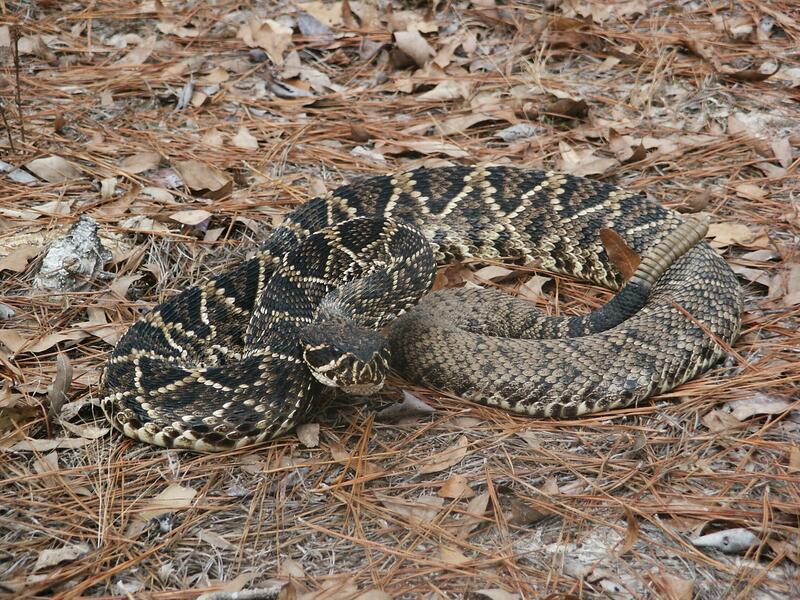







Loading profile. Please wait . . .
Crotalus adamanteus Beauvois, 1799
Eastern Diamond-backed Rattlesnake




Federal Protection: No US federal protection
State Protection: No Georgia state protection
Global Rank: G3
State Rank: S3
Element Locations Tracked in Biotics: Yes
SWAP 2015 Species of Greatest Conservation Need (SGCN): Yes
SWAP 2025 Species of Greatest Conservation Need (SGCN): Yes
2025 SGCN Priority Tier: Moderate Conservation Concern
Element Occurrences (EOs) in Georgia: 263
Habitat Summary for element in Georgia: Early successional habitats on barrier islands and mainland; pine flatwoods; sandhills; maritime forests/hammocks; ruderal habitats
The largest venomous snake in the United States and the largest rattlesnake in the world, eastern diamond-backed rattlesnakes may reach over 2.1 m (7 ft) and weigh as much as 6 kg (13.2 lbs). Males reach larger sizes than females. A series of linked, yellow- or cream-bordered diamonds with brown centers extend from behind the head and to nearly the end of the tail, progressively fading posteriorly. The belly is cream colored and slightly mottled. The head is very large and much wider than the neck. Two parallel yellow or cream lines border a dark band on each side of the head that includes the eye. The tail terminates with a rattle containing one or more (often exceeding 10) loose, hard keratin segments, that when shaken creates a loud buzzing sound. Newly born eastern diamondbacks are 31-38 cm (12.1-14.9 in) in total length and have only a single “button” on the tail tip.
In Georgia, the timber (a.k.a. canebrake) rattlesnake (C. horridus) may be confused for an eastern diamondback, but only because both can be large and have substantial rattles on the tail. Timber rattlers can be easily distinguished by having a series of dark, chevron-shaped crossbands down the length of the body, rather than diamonds.
Eastern diamond-backed rattlesnakes occupy a variety of sandy upland habitats including sandhills, clayhills, flatwoods, and old-fields and other ruderal settings. Primarily during the colder months, gopher tortoise burrows and stump holes within and near these habitats are used for shelter from temperature extremes, predators, and wildfires. In coastal areas, including on the sea islands, these snakes are most often found in grassy and shrubby interdunal meadows.
Small mammals including rats, squirrels, and especially rabbits are eaten. Birds have been documented as prey, but consumption of them is very sporadic and highly opportunistic.
Courtship, mating, and birthing take place August through September. Females are capable of storing sperm and delaying fertilization, giving birth every 2-3 years. Litters range in size from 8-29 young with an average of 14. Males mature quicker and can successfully mate in their third year; females mature after four years. Longevity may be 20 years or more. Known predators include raptors, king and indigo snakes, and wading birds.
Visual encounter surveys near gopher tortoise burrow concentrations (or in secondary dunes on islands) on seasonably-warm winter days are the most effective way to locate eastern diamondbacks. The use of burrow cameras and scheduling surveys after fresh burns will increase the odds of locating them. Box traps with drift fence leads are effective at capturing wandering snakes, but require significant labor to build and install, and must be checked daily. Intact, shed skins can be positively identified by experts.
This species is confined to the Coastal Plain and ranges from southeastern North Carolina south and west to eastern Louisiana, including all of Florida.
All snake species in Georgia are threatened by malicious killing from those that believe “the only good snake is a dead snake.” This is obviously more true for the few species like the eastern diamondback that are venomous and indeed potentially dangerous. This species is especially targeted by those that collect snakes for rattlesnake roundups and the skin trade. However, the greatest threat to this and other upland coastal plain species is the loss, alteration, and fragmentation of habitat, including that caused by fire suppression or exclusion. Because of their high reliance on gopher tortoise burrows for winter shelter, eastern diamondbacks are indirectly impacted by the decline of that species.
| Threat 1 | Threat 2 | Threat 3 | |
|---|---|---|---|
| General Threat | Natural system modifications | Biological resource use | Residential & commercial development |
| Specific Threat | Fire & fire suppression | Hunting & collecting terrestrial animals | None |
Eastern diamondbacks are found on most public lands in the coastal plain except those with only lowland habitats and those found near the Fall Line in the eastern part of the state (where they do not range north into).
Educational efforts promoting the ecological value of venomous snakes and their low level of threat if left alone must continue to reduce the unnecessary destruction of them. Managing habitats by prescribed burning and other methods to enhance groundcover and limit encroaching hardwoods is critical to this and many other species associated with coastal plains uplands. Only one rattlesnake roundup still exists in Georgia – Whigham. Conversion of this highly detrimental event into a wildlife-friendly festival, as was progressively done in Fitzgerald and Claxton, is strongly recommended.
Martin, W. H., and D. B. Means. 2000. Distribution and habitat relationships of the Eastern Diamondback Rattlesnake (Crotalus adamanteus). Herpetological Natural History 7:9-34.
Means, D. B. 2008. Eastern Diamondback Rattlesnake: Crotalus adamanteus. Pp. 430-432 In Jensen, J. B., C. D. Camp, W. Gibbons, and M. J. Elliott (eds.). Amphibians and Reptiles of Georgia. University of Georgia Press, Athens. 575 p.
Speake, D. W., and R. H. Mount. 1973. Some possible ecological effects of "rattlesnake roundups" on the southeastern Coastal Plain. Proceedings of the Annual Conference of the Southeastern Association of Game and Fish Commissions 24:267-271.
Timmerman, W. W., and W. H. Martin. 2003. Conservation guide to the Eastern Diamondback Rattlesnake, Crotalus adamanteus. Society for the Study of Amphibians and Reptiles. Herpetological Circular 32:1-64.
John B. Jensen
4/25/18